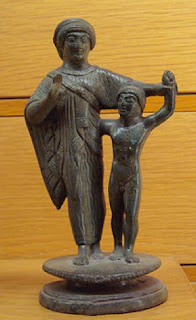 |
| Menrva (Etruscan Minerva) with thunder |
Exiled from her usual library, and not one to waste valuable research time, Turfa went to Bryn Mawr's Classics library instead. It was there that she found an article which led her to the Etruscan Brontoscopic Calendar, an almanac telling what the rumble of thunder signifies on any given day of the year.
Brontoscopic?!?
Brontos means "thunder" in Ancient Greek. (Any 8-year-old boy will tell you brontosaurus means "thunder lizard")
Scopic means "seeing" and by association "prediction", so...
Brontoscopic means PREDICTION BY THUNDER.
Yes, thunder was considered a means of prophecy in ancient times.
 |
| Etruscan civilisation flourished c. 850 BC-AD 50 |
The Etruscans believed the gods spoke through natural phenomena, like lightning or deformed animals. Some of their wisest members learned how to interpret omens. (An omen is any event regarded as a portent for good or evil. The word omen is Latin for "sign".)
In ancient Rome, if you wanted to know what the future held in store for you, your first stop would probably be an Etruscan soothsayer. There were two types of soothsayers.
 |
| Etruscan model of a liver for divination |
The Augur looked abnormal phenomena in the celestial sphere. Not just the flights of birds, but also clouds, rainbows, eclipses... and thunder. Hence the Etruscan Brontoscopic Calendar.
WHEN WAS IT WRITTEN?
 |
| Yes, they had cosmic rays back then |
WHO WROTE IT?
 |
| Etruscan adult and child (Louvre) |
Then, after the Etruscans adopted the Greek alphabet a century later, it might have been written down on papyrus, cloth or metal. In the first century BC it was translated from Etruscan into Latin by a contemporary of Julius Caesar named Publius Nigidius Figulus. Six hundred years after that, Figulus's Latin version was translated into Byzantine Greek by a scholar named John the Lydian at the court of Justinian. And that is how it has come down to us.
WHAT DOES IT SAY?
The Etruscan Brontoscopic Calendar is a kind of almanac. It assumes that for every day of the year in Etruria, thunder has a different meaning. All the entries begin with the same phrase ει βροντηση - "If it thunders..." The formula goes: If it thunders, then such and such will happen. For example:
June 1 - If it thunders, then there will be a destruction of crops except barley...
In her lecture, Dr. Turfa said boring agricultural entries like the one above show that Etruscan Brontoscopic Calendar is almost certainly genuine. If it was a Roman or Byzantine forgery, then Figulus or John the Lydian would have spiced it up a bit. However, the almanac is mostly concerned with crops and animals, i.e. FOOD. (Those of us in the affluent 21st century forget just how hard it was to keep food on the table in ancient times.) There are also a lot of mentions of threatening wars and assassination of leaders.
 |
| The Thunder Omen |
June 15 - If it thunders, feathered creatures shall be injured during the summer and fishes shall perish.
June 28 - If it thunders, there will be drought and a plague of poisonous reptiles.
August 5 - If it thunders, it means women will be wiser than men.
August 19 - If it thunders, women and slaves will dare to commit murder.
October 7 - If it thunders, there will be fewer beans but more wine.
October 23 - If it thunders, the people will be of marvellously good cheer.
December 15 - If it thunders, many will set out for war, but few will return.
December 29 - If it thunders, there will be a healthy leanness of bodies.
January 22 - If it thunders, there will be plenty but also an abundance of mice and deer.
 Dr. Turfa's lecture touched on many other fascinating topics such as Caesar's revision of the calendar, an eruption of Vesuvius c. 1780 BC and the earliest chicken wing to be found in Europe (in a hut near Castelgandolfo). Many of her erudite nuggets will no doubt appear in her forthcoming book, Divining the Etruscan World: The Brontoscopic Calendar and Religious Practice. But you can see the thunder omens for each day in an appendix of The Religion of the Etruscans (right) and also HERE.
Dr. Turfa's lecture touched on many other fascinating topics such as Caesar's revision of the calendar, an eruption of Vesuvius c. 1780 BC and the earliest chicken wing to be found in Europe (in a hut near Castelgandolfo). Many of her erudite nuggets will no doubt appear in her forthcoming book, Divining the Etruscan World: The Brontoscopic Calendar and Religious Practice. But you can see the thunder omens for each day in an appendix of The Religion of the Etruscans (right) and also HERE.[The first of the Roman Mysteries Scrolls series for kids 7+ is The Sewer Demon. Other titles include The Poisoned Honey Cake and The Thunder Omen. The 17+ books in the existing Roman Mysteries series are perfect for children aged 9+, especially those studying Romans as a topic in Key Stage 2. The Roman Mysteries are available on DVD and also Amazon Prime.]
Fascinating! Thanks for the excellent overview.
ReplyDelete